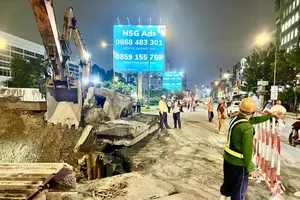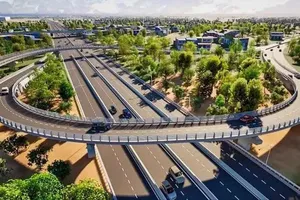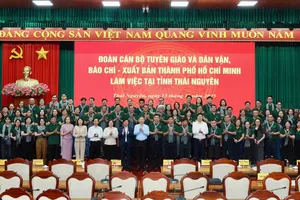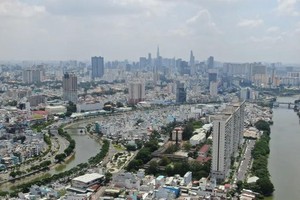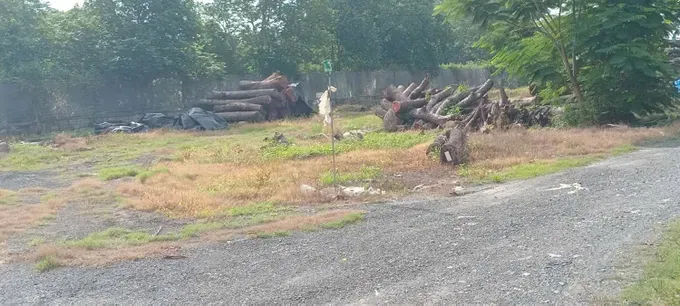
HCMC's sidewalks are lined with a diverse range of tree species, including dipterocarpus, khaya, tamarind, copperpod, and monkey pod. During ground clearance for infrastructure projects, many of these trees are impacted, stunting their growth. Others suffer natural damage as they develop, creating safety hazards during periods of rain and high winds.
To ensure public safety on the roads, the municipal authorities have had to remove a significant number of trees, including many valuable and long-standing specimens. A recent case highlighted in HCMC involved the mass felling of trees during a sidewalk renovation project.
After being felled, the timber is transported to one of two collection sites, either Dong Thanh Nursery, managed by HCMC Greenery Parks Co. Ltd. (in Hoc Mon District), or a wood yard operated by Green Environment Construction Co. Ltd. (in Cu Chi District).
A visit in mid-May 2025 to Dong Thanh Nursery revealed a large volume of timber of various species. Vast quantities of logs were seen lying exposed to nature in an open-air yard, with some being already covered in red mud. At the Green Environment Construction Co. site, situated on a fenced-off vacant lot, many logs had discolored and were covered in moss.
The HCMC Center for Technical Infrastructure Management (under the municipal Department of Construction) reports that once the wood is collected, it initiates a process to select an organization for appraisal and valuation, followed by the selection of an auction house.
Data on past auctions reveals a lucrative trade:
- On October 19, 2021, the HCMC Center for Technical Infrastructure Management auctioned a wood lot of approximately 1,442m³ of mixed wood - including Red Lauan, Acacia coral, monkey pod, and dipterocarpus – with a starting price of over VND3.3 billion (US$132,000).
- In 2022, two auctions were held. The first was for a lot of 454.4m³ collected in the first half of the year. The second was for 303m³ of various roundwood collected in the latter half, with a starting price of VND1 billion ($40,000).
- In 2023, two lots of 321m³ were auctioned from January to August, and another 222m³ from September to December with a starting price of VND700 million ($28,000).
- Between January and September 2024, three auctions were held for a total of approximately 600m³, with a combined starting price of VND2.5 billion ($100,000). A significant portion of this timber came from inner districts.
Potential buyers are normally directed to contact the winning auctioneer, a branch of the Vietnam Auction Partnership Co. in Phu Nhuan District. Wood is not auctioned by individual species; instead, all types are consolidated and sold by the cubic meter. An employee there disclosed that a lot of 117.71m³ from early 2024 remained unsold past its deadline, and the company was in discussions with the HCMC Center for Technical Infrastructure Management.
Regarding the handling of felled trees, Deputy Director Vo Khanh Hung of the HCMC Department of Construction stated that all raw timber is inventoried and stored at a site designated by the tree management unit or project investor, as stipulated in the felling permit.
The recovered firewood and timber are then liquidated through a nationwide public auction process as required by law. The Deputy Director noted that the Department of Construction has not encountered any significant difficulties with this procedure.
Trees are only felled or relocated under specific conditions: when they show signs of instability, disease, or poor growth; after falling due to severe weather; or to clear the way for key municipal and national construction projects.
He clarified that there is no policy of felling trees for the primary purpose of sidewalk renovation. The recent incidents reported by the media, he explained, were due to construction contractors failing to follow guidelines for protecting trees within their work zone.
This negligence compromised the trees’ stability, leaving the management unit with no choice but to remove them to ensure the safety of residents and tourists after other measures – such as pruning, canopy reduction, and cable bracing – proved ineffective.
According to HCMC Greenery Parks Co. Ltd., there is an annual plan to replace approximately 600 trees that are dead, damaged, diseased, or otherwise unsafe. This regular replacement includes long-lived species like dipterocarpus and monkey pod (over 60 years old) and others like Copperpod and tamarind (over 30 years old).
This replacement program has a minimal net impact on the inventory of large “type 3” trees (trunks over 20cm in diameter), as about 500 smaller trees mature into this category each year. Currently, the city’s 84,499 trees are maintained through a public bidding process. This canopy includes 5,298 newly planted trees alongside many ancient ones dating back to before 1975, with some from the French colonial era reaching heights of 30-40 meters.
Deputy Director Vo Khanh Hung further informed that HCMC’s public park development program for 2020-2030 aims for a green space ratio of 1m² per person by 2030. However, given the city’s limited land availability, creating new parks and planting more trees is a resource-intensive, long-term challenge.
Therefore, the city’s top priority is the diligent maintenance and upkeep of the existing parks, green spaces, and urban trees to ensure they remain safe and aesthetically pleasing for the city.








